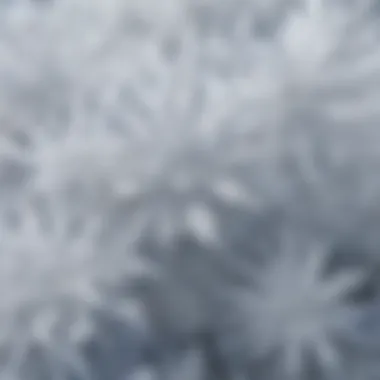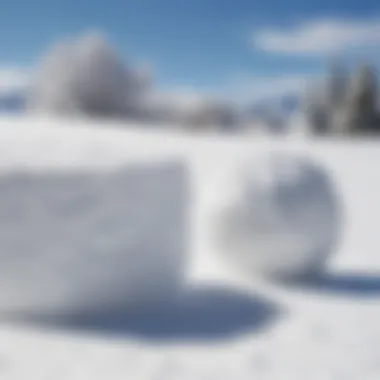The Science Behind Fake Snow: Composition and Uses


Intro
Fake snow stands as a fascinating outcome of scientific innovation. The development of artificial snow was primarily pursued for recreation, particularly in ski resorts and weather-related installations. As scientists and engineers delve deeper into its complexities, we begin to uncover the various aspects of its composition and production. Artificial snow is not merely a synthetic imitation; it possesses traits and applications that reveal fascinating truths about our environment and technology.
Science Fun Facts
- Actual snowflakes have a structure uniquely different from one another, and no two snowflakes are the same. In contrast, fake snow is often manufactured to be uniform in appearance.
- The earliest attempts at creating artificial snow date back to the 1940s with the invention of snow-making machines, initially used to assist skiers.
- Modern engineering has led to snow-generated films and events, manifesting a realistic
Prelude to Fake Snow
The study of fake snow spans multiple disciplines, combining elements of chemistry, environmental science, and applied engineering. Understanding its use and effects leads to valuable insights about our environment and recreational facilities. Advancements in fake snow technology may redefine how we engage with winter sports, special effects, and even festive decorations.
Definition and Purpose of Fake Snow
Fake snow, commonly known as artificial snow, is a material created to simulate natural snow. This material is produced for various applications that require snow-like conditions. The primary purpose is to offer similar aesthetic and functional benefits as natural snow without the dependency on weather conditions. This includes its extensive use in film, theater productions, and snow sports. Additionally, artificial snow allows creators to manipulate environmental factors for desired effects, making it versatile in both recreational and festive settings.
By producing snow on demand and controlling its quality, stakeholders can enhance experiences, optimize use in venues, and ensure reliable conditions for skiing and filming.
Historical Overview of Fake Snow
The origin of fake snow traces back to the mid-20th century when engineers sought to extend ski seasons despite fluctuating weather patterns. The first substantial development occurred in 1950, with the invention of a snow-making machine that utilized compressed air and water. This machine changed winter sports significantly by extending ski operations and providing consistent terrains.
During the 1980s, with advances in polymer technologies, different types of fake snow formulations emerged. Manufacturers began developing specific compounds, which offered increasing realism in texture and appearance. As specialists focused on environments in the production of cinema, fake snow began play crucial role in creating believable winter scenes.
In recent years, the urgent need for eco-friendly options has influenced developments and practices. The industry now embraces sustainability as an essential consideration while expanding its applications in various sectors. Organizations strive to balance the demands of winter recreation without inflicting damage to the natural ecosystem.
This historical journey highlights the ongoing evolution of artificial snow and emphasizes its important role in multiple sectors, breaking barriers impacted by climate variations.
Types of Fake Snow
Understanding the types of fake snow is crucial in recognizing the multiple avenues it opens up for various applications. Each type has specific attributes, ranging from composition to potential impact on the environment. Recognizing these aspects helps consumers and creators make informed decisions. This knowledge can illuminate the benefits and drawbacks of each variant, assisting in proper selection for events and developments across industries.
Chemical Snow Compounds
Chemical snow compounds are commonly used to create artificial snow for a variety of settings. The primary ingredient in these formulations is water, usually combined with a range of other chemical agents to achieve specific effects. Examples include sodium bicarbonate and detergent, which play essential roles in producing snow-like textures and qualities.
The advantages of chemical snow lies in its ease of use and availability. These compounds can be simply mixed with water to produce an impressive snow-like material suitable for film sets or ski slopes. However, they also present challenges - issues regarding health and environmental concerns may arise. It's essential to review the safety information to understand any long-term implications for users and outdoor ecosystems.
Synthetic Polymer-Based Snow


Synthetic polymer-based snow offers another method of producing artificial snow. This type of snow is made primarily from polymers, such as polyacrylate, which can hold substantial amounts of water. When hydrated, these polymers create fluffy snow-like structures that do not require constant replenishment.
The notable advantage of synthetic polymers is their durability. Once made, they can last longer than traditional snow, offering an excellent solution for themed events or attractions. However, one must weigh this advantage against potential ecological impacts. Synthetic polymers aren't biodegradable, potentially leading to long-term waste. Delving into recycling and disposal strategies is vital for minimizing their carbon footprint.
Biodegradable Alternatives
The development of biodegradable alternatives represents a promising frontier in the world of fake snow. Companies are increasingly investigating natural materials, such as biodegradable starches, which offer snow-like properties without the environmental baggage that synthetic products carry. This blends innovation with sustainability, addressing a significant concern today.
Opting for biodegradable options helps reduce waste and mitigates the long-term environmental effect injection in ecosystems. Furthermore, as technology matures, these products might become more accessible. Surveys show a growing consumer preference for eco-consciousness. Thus, suppliers can enhance their appeal through transparent and eco-friendly practices.
In summary, each type of fake snow contributes uniquely to various industries. Making conscious choices about composition leads to better outcomes. Staying aware of performance and implications is the key to successful utilizations of these products.
The Science of Snow Creation
Understanding the science behind snow creation is essential to grasp the broader discourse on artificial snow. This section delves into the fundamental properties and production techniques, illuminating not only how fake snow imitates natural snow but also the scientific principles involved in its synthesis.
Physical Properties of Snow
Snow, whether real or fake, exhibits specific physical properties that affect its appearance, texture, and behavior. Some key attributes include:
- Density: The density defines how light and fluffy the snow appears. Fake snow can be adjusted in density to match specific environmental needs.
- Albedo: This refers to the reflectivity of the snow. Higher albedo means more light is reflected back, making the snow appear brighter and more visually appealing.
- Particle Size: The size of the snow particles influences how it packs and its melting behavior. Smaller particles will often create a powdery texture, while larger flakes may clump together.
Each of these characteristics plays a vital role in ensuring the fake snow performs similarly to natural snow. These properties can be controlled during the production phase, mirroring nature’s diversity in snow types.
Techniques for Producing Fake Snow
Artificial snow-making technology has advanced significantly, providing several methods for creating effective fake snow. Each technique has its own benefits and challenges:
- Snow Cannons: This equipment uses compressed air and water to create small ice particles that freeze in the air before falling to the ground. It is quite effective for ski resorts.
- Chemical Processes: Some types of fake snow are created from chemical compounds designed to imitate the structure and feel of real snow. These include products that can be sprayed or dusted onto surfaces.
- Polymers and Crystals: Synthetic polymers create a snow-like effect when water mixes with them. This form can be used for decorations and events, allowing for easier handling and cleanup.
The method used often depends on the intended application, cost considerations, and environmental impact.
Successful snow-making involves not just the application of technology, but also an understanding of temperature conditions, humidity, and target end-use, aligning practical needs with scientific principles. As these techniques improve, they provide limitless possibilities for the applications and experiences offered by fake snow.
Applications of Fake Snow
Fake snow is more than just a novelty; it is an essential component in various industries. Understanding its applications reveals its multifaceted significance. Exploring the sphere of fake snow offers insights into not only entertainment but also functionality in different settings. The consideration of its applications can broaden perspectives on its contributions to society and various events.
Use in Film and Theater
The film and theater industries often rely on fake snow to create realistic and immersive environments. Productions that portray winter landscapes use artificial snow to enhance the visual narrative. Unlike real snow, which can melt or not fall in sufficient amounts, fake snow provides a controlled option. It can be applied on demand, ensuring consistent scenery throughout productions. This means that filmmakers can shoot scenes at any time of the year, regardless of weather.


Moreover, the versatile forms of fake snow contribute heavily to artistic choices. Textures can be customized, creating powdery snow or layered dumps for different scenes. For example, looking at a spectacular winter wonderland scene can impress the audience. This intentional blending of narratives forms an essential aspect of the theatrical and filmic experience, ensuring the scenery matches the storyline.
According to industry experts, the use of fake snow in productions has increased since advancements in technology, providing more realistic effects.
Artificial Ski Slopes
Artificial ski slopes are another significant avenue where fake snow shows its importance. Ski resorts often depend on synthetic snow for their operations. Climate changes have led to increasingly unpredictable weather, jeopardizing winter sports. To combat this uncertainty, the artificial creation of snow forms crucial support for both business and recreational purposes.
Essentially, making snow for slopes involves using snow-making machines. These create small ice crystals that accumulate into snow instead of depending solely on natural snowfall. Resorts implement these types of snow systems to ensure they can provide reliable skiing conditions, thus maintaining popularity among enthusiasts. Additionally, the precision in shaping slopes allows for better management of ski activities through constant monitoring and maintenance.
Decorative Uses in Events
The application of fake snow also stretches into festive events and occasions. Decorative use of synthetic snow appears frequently during holidays, weddings, or corporate parties. This adds an enchanting visual element while sparking joy and showcasing creativity.
Using fake snow in decorations permits customization, making specific areas appear wintery without adverse weather conditions. For settings where authenticity enhances the experience—like holiday markets or themed parties—fake snow provides an aesthetic boost. It creates an atmosphere that can evoke cheer and wonder among guests. Often, organizers implement fakes to complement other decor effectively. This transforms venues into a magical wintry landscape.
In summary, the applications of fake snow underscore its importance across film, recreational sports, and event decoration. As people continue to explore revolutionary trends in fake snow-making, one realizes its influence correlates with adaptations in varying environments.
Environmental Considerations
Importance of Environmental Considerations
Environmental considerations surrounding fake snow are crucial. The production and application of artificial snow can have noticeable effects on surrounding ecosystems. Understanding these elements helps in making informed decisions about its use and potential impact. Importance lies in recognizing both benefits and drawbacks.
Impact of Synthetic Snow on the Ecosystem
Synthetic snow has multiple impacts on the ecosystem and it is necessary to assess them closely. Generally made from chemical compounds or polymers, content in synthetic snow may not easily break down. If released into nature, it can affect soil quality and water systems.
- Chemical Leaching: In periods of heavy rainfall, chemical components can wash into local water sources. This affects aquatic life and local flora and fauna.
- Habitat Alteration: If used in large areas, synthetic snow can alter habitat conditions. Instead of natural snow, which provides insulation to species like insects and small mammals, synthetic snow may create harsh environments.
- Microplastic Concerns: Many synthetic snow types utilize materials that can break down into microplastics. These smaller particles can infiltrate ecosystems, accumulating in the food chain.
Awareness is key to mitigating these concerns. It is vital to monitor and assess these impacts and adjust practices accordingly to minimize ecological harm.
Developing Sustainable Options
With growing awareness of the opportunities and threats posed by synthetic snow, numerous strategies exist to develop sustainable options.
- Biodegradable Materials: Focused research and development have begun to emphasize the importance of utilizing natural and biodegradable materials in fake snow production. Options such as plant-based compounds could offer great alternatives.
- Water Usage Efficiency: Improving techniques that use water responsibly means less impact on local environments. Technologies that recirculate and reuse water can be very beneficial.
- Community Awareness: Educating users about the best practices and possible consequences can empower communities. Community initiatives can raise awareness and lead to informed decision-making regarding the use of synthetic snow in various applications.
“The future of snow making lies in the balance of usability and responsibility.”
Exploring these avenues is not only beneficial for present conditions but plays a significant role in ensuring a sustainable future.


Future Trends in Fake Snow Production
The landscape of fake snow production is constantly evolving. It is central to understanding the future of this artificial material. As global temperatures rise, innovative methods for creating realistic snow are becoming crucial. The need for more sustainable solutions aligns with increasing environmental awareness from consumers and industries alike. By investing in research and technology, companies aim to meet both aesthetic demands and ecological responsibilities.
Innovative Technologies in Snow Making
Advancements in technology are reshaping the methods used to generate fake snow. In recent years, there has been a surge in the development of high-efficiency snow guns. These devices blend compressed air, water, and now nano-particles technology to create snow-like crystals instead of standard snow flakes. Not only are they more resource-efficient, but they also produce finer, softer snow that mimics natural snow qualities more closely. This innovation can allow for better performance on ski slopes and festive displays.
Moreover, companies are exploring biomimicry—an approach that looks to nature for inspiration. This approach might lead to creating systems that utilize the properties of water and temperature to generate snow flakes that resemble real snow. Another interest is in the use of smart technologies. Sensors powered by artificial intelligence can monitor weather conditions. They can determine the optimal times to produce snow, consequently enhancing efficiency while reducing waste.
Regulatory Trends and Policies
As awareness grows regarding environmental impacts, regulations affecting synthetic snow production are in flux. Many regions are starting to set more stringent guidelines concerning water usage and chemical components in snow-making processes. These guidelines reflect a blend of conservation efforts urged by both the public and environmental advocates.
An important driver is the shift towards green chemistry principles, which seeks to replace harsh chemicals with safer, more sustainable materials. Some companies are beginning to adopt practices that involve transparency about their production methods and the environmental effects of their products. This evolution may influence policies established by governing bodies on a global scale.
A few relevant trends include:
- Limitations on water use for creating fake snow in areas experiencing drought conditions.
- Bans on certain chemicals that can negatively impact wildlife and ecosystems.
- New taxes or incentives to encourage companies toward eco-friendlier practices.
The outlook suggests that increased governance is likely, promoting innovation in creating eco-friendly alternatives in the snow industry. Familiarity with precautions and sustainable practices can act as a guideline for future endeavors.
“The future of fake snow production hinges on technology and sustainable practices ensuring that innovations match environmental necessities.”
By examining these trends, we can underscore the interplay between creativity and responsible production methods in fake snow manufacturing.
Ending
Understanding fake snow is not only about its fun and decorative aspects. It serves important roles in various fields, including entertainment and sports. The rise in resultant technologies has led to safer, more efficient methods for production. Additionally, there is a noticeable shift towards sustainable practices, which cannot be overlooked.
Recap of the Importance of Fake Snow
Fake snow offers practical applications for multiple industries. In film and theater, it sets a magical scene, enhancing visual storytelling. Its use in artificial ski slopes allows winter sports to flourish, regardless of real weather conditions. Moreover, as events adopt elaborate themes, fake snow helps create immersive experiences that compel guests.
Environmentally, fake snow highlights considerations around synthetic versus biodegradable materials. The recent advancements speak of the trajectory towards an eco-friendly future within this industry. Likewise, its role in education can be emphasized, assisting young learners in grasping complex scientific principles through a relatable medium.
Encouragement for Further Exploration
As we seek knowledge, exploring fake snow’s impact may spark curiosity. Those interested in environmental science should probe deeper into the ways these synthetic alternatives influence our ecosystems and climate.
Also, consider investigating the latest technologies that shape snow-making processes today. Discussions about potential regulations and their effects on production practices encourage awareness. Knowledge in this sphere not only empowers young minds but fosters responsible citizenship in caring for our environment.
Engaging with communities, both online and offline, can elevate understanding about not just fake snow, but overall sustainability debates in artificial substances. Resources like Wikipedia and Britannica offer extensive information for budding scientists.
“Knowledge is an infinite domain, where inquiry transforms the known into the spectrum of possibilities.”
By embracing this area of study, promising scientists of tomorrow can contribute to advancements that respect ethical practices while still igniting imaginations. Let the exploration begin.







